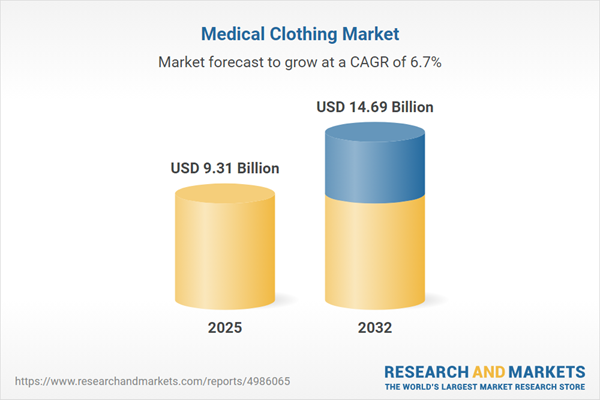Speak directly to the analyst to clarify any post sales queries you may have.
The medical clothing market is undergoing significant change, shaped by technological innovation and evolving regulatory expectations. For senior decision-makers, refining sourcing and compliance strategies is essential to capitalize on emerging opportunities while safeguarding institutional performance and workforce safety.
Market Snapshot: Medical Clothing Market Growth and Trends
The global medical clothing market demonstrates robust and steady growth, anchored by consistent demand from hospitals, outpatient centers, and a broad range of healthcare facilities. Procurement leaders are prioritizing investments in protective apparel that advances both infection control and wearer comfort. Innovations, including antimicrobial fibers and moisture-wicking materials, are transforming worker safety and driving efficiency in clinical settings. Accelerated adoption of digital procurement platforms is speeding sourcing cycles, ensuring regulatory alignment, and integrating supply networks at a global scale. These developments support operational agility and help organizations adapt to changes in care models and industry standards.Scope & Segmentation: Strategic Overview for the Medical Clothing Market
- Product Types: Medical headwear, such as bouffant, disposable, and tie-back caps, underpins infection control protocols and fits numerous clinical applications. Clinical footwear, including boots, clogs, and specialized sneakers, caters to workplace safety. Apparel—spanning lab coats, scrubs, and surgical gowns—supports a variety of patient groups and settings. Disposable, reclaimed, and reusable formats enable facilities to adapt to the latest hygiene and infection control standards.
- Material Types: Antimicrobial textiles are central to infection prevention strategies. Blended cotton-polyester fabrics offer durability and comfort, pure cotton supports breathability, and nonwoven materials meet quick single-use demands. Polyester ensures endurance for frequent use, while all materials are vetted for ergonomic suitability and regulatory compliance within the medical clothing market.
- End Users: Hospitals require extensive apparel lines for specialized functions. Ambulatory surgery centers, urgent care clinics, rehabilitation facilities, dental practices, and veterinary clinics benefit from tailored medical garments that align with unique workflows and comply with specific regulatory requirements.
- Distribution Channels: Direct procurement, collaborative supplier relationships, digital marketplaces, and subscription-based supply enable scalable and flexible sourcing. Wholesale channels address procurement complexity and support organizations of varying sizes.
- Regional Coverage: North and Latin America focus on integrated supply networks and large-scale sourcing. EMEA prioritizes customization in response to regional regulations. Asia-Pacific is responsive to regulatory updates and diverse care delivery needs, accelerating adoption of new standards.
- Company Profiles: Key manufacturers such as Medline Industries, Cardinal Health, 3M, Kimberly-Clark, Mölnlycke Health Care, Owens & Minor, DuPont, Johnson & Johnson, Ansell, and Smith & Nephew drive specialized product development and efficient sourcing to help meet evolving operational and compliance goals in healthcare organizations.
Key Takeaways: Strategic Insights for Senior Decision-Makers
- Rising regulatory expectations accelerate the adoption of antimicrobial fabrics, supporting compliance and mitigating organizational risk in diverse care environments.
- Next-generation textile integration and ergonomic design are improving adaptability and enhancing operations across both traditional and emerging care models.
- Regional manufacturing and proactive inventory controls are enhancing supply chain resilience, minimizing exposure to sudden disruptions and logistical challenges.
- Commitment to environmental sustainability is steering organizations toward eco-friendly materials and optimized logistics that support responsible sourcing and lower impact.
- Smart textiles, such as garments with sensor capabilities, are contributing to real-time patient monitoring and supporting data-driven clinical decisions for improved practices.
- Strategic market priorities reflect regional dynamics; established markets prioritize advanced technical apparel, while emerging regions pursue scalable, value-oriented procurement approaches.
Tariff Impact: Navigating Trade Disruptions in Medical Clothing
Recent U.S. tariffs on imported medical apparel are influencing sourcing decisions and adding new challenges to procurement strategies. Healthcare organizations are meeting this complexity by working with expanded supplier networks, adopting agile supply chain models, and embracing flexible warehousing and contract terms. These responses are considered necessary for maintaining operational continuity in an evolving policy environment.
Methodology & Data Sources
This analysis draws on interviews with healthcare professionals, insights from regulatory specialists, and input from leading manufacturers. It is complemented by a review of regulatory documentation and financial records, resulting in a comprehensive assessment of the medical clothing sector.
Why This Report Matters: Actionable Benefits for Leaders
- Prepares senior leaders to proactively manage changing regulatory requirements and optimize sourcing and risk mitigation within the medical clothing market.
- Delivers practical recommendations to elevate quality standards, advance environmental initiatives, and maximize value for a variety of healthcare operations.
- Strengthens organizational competitiveness and resource efficiency as market expectations and business models evolve rapidly.
Conclusion
This report supplies senior decision-makers with essential guidance on navigating regulatory challenges, building resilient supply strategies, and supporting sustainable growth in the medical clothing sector. Organizations applying these insights are well positioned to realize operational excellence and strategic adaptability.
Additional Product Information:
- Purchase of this report includes 1 year online access with quarterly updates.
- This report can be updated on request. Please contact our Customer Experience team using the Ask a Question widget on our website.
Table of Contents
3. Executive Summary
4. Market Overview
7. Cumulative Impact of Artificial Intelligence 2025
Companies Mentioned
The companies profiled in this Medical Clothing market report include:- Medline Industries, L.P.
- Cardinal Health, Inc.
- 3M Company
- Kimberly-Clark Corporation
- Mölnlycke Health Care AB
- Owens & Minor, Inc.
- DuPont de Nemours, Inc.
- Johnson & Johnson
- Ansell Limited
- Smith & Nephew plc
Table Information
| Report Attribute | Details |
|---|---|
| No. of Pages | 187 |
| Published | October 2025 |
| Forecast Period | 2025 - 2032 |
| Estimated Market Value ( USD | $ 9.31 Billion |
| Forecasted Market Value ( USD | $ 14.69 Billion |
| Compound Annual Growth Rate | 6.7% |
| Regions Covered | Global |
| No. of Companies Mentioned | 11 |









